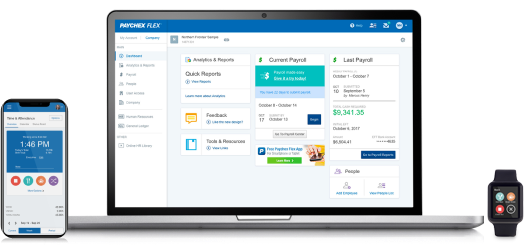U.S. DOL’s Final Rule on Independent Contractors Set to Take Effect March 11 Despite Litigation: What You Should Know
Compliance • Article • 4 min. Read • Last Updated: 02/07/2024

Limited Time Offer
Three Months Free Payroll
Paychex makes it easy to pay and manage employees
Table of Contents
- What Is the U.S. DOL's Final Rule on Worker Classification?
- Explanation of Factors Used in Determining Worker Classification
- Do Employers Have Additional Worker Classification Requirements?
- How Will the New Worker Classification Rule Impact Businesses?
- What is the Opposition to the Final Worker Classification Rule?
- Paychex Can Help
The U.S. Department of Labor (DOL) published its Final Rule on Employee or Independent Contractor Classification in the Federal Register on Jan. 10, 2024, to provide guidance for employers in determining worker classification under the Fair Labor Standards Act (FLSA). An employee is entitled to wage and hour protections under the FLSA that would not be available to a worker classified as an independent contractor.
The final rule, which is schedule to take effect March 11, 2024, rescinds the previous administration’s 2021 rule and uses an analysis that aligns more closely with longstanding judicial precedent. The rule is facing four separate lawsuits, including in Texas, Georgia, Tennessee, and Louisiana, from freelance writers to a trucking company. Even one chamber of Congress proposed a bill to nullify the rule. If these challenges are successful, it is possible the 2021 rule could remain in effect.
Regardless of which rule or test applies, independent contractor misclassification can be a significant compliance concern for businesses.
What Is the U.S. DOL's Final Rule on Worker Classification?
The final rule uses a totality-of-the-circumstances analysis that considers six factors, giving no individual factor predetermined weight. The factors include:
- Opportunity for profit or loss depending on managerial skill*
- Nature and degree of control*
- Degree of permanence of the work relationship
- Work performed is an “integral” part of the potential employer’s business
- Specialized skill and initiative
- Relative amount of investment of capital or entrepreneurial effort by the worker
- compared to investment by potential employer
*These were the core factors that were given more weight under the previous 2021 rule.
The rule also indicates that additional factors could possibly be used if they in some way illustrate the economic dependence between a worker and potential employer.
Employee Retention Tax Credit: Deadlines, Eligibility, and What to Know to Apply

Explanation of Factors Used in Determining Worker Classification
The opportunity for profit or loss factor looks at how a worker’s managerial skill impacts their economic success or failure in performing the work. Examples include the worker negotiating what they will charge for the work, engaging in marketing or advertising, and having the power to accept/reject jobs, hire talent, purchase materials, rent space, etc. If a worker has no opportunity for a profit or loss, then they could be an employee.
Under the nature and degree of control factor, if, for example, the potential employer sets workers’ schedules, supervises the work, oversees any discipline required, then indications are that the individuals being scheduled and supervised are employees.
In considering the degree of permanence factor, a continuous, indefinite, or exclusive work relationship would indicate employee status, while a more project-based or non-exclusive relationship could indicate independent contractor status.
If the work performed is critical or central to the potential employer’s principal business, then it is an integral part of the employer’s business, and this factor leans toward the worker being an employee. Conversely, if work performed is not critical or necessary, this factor would weigh toward the worker being an independent contractor.
When reviewing the skill and initiative factor, if a worker needs training or is applying no specialized skills to perform the work, then the indication would be that their status is an employee.
Note: The Final rule only applies when determining worker classification under FLSA.
Do Employers Have Additional Worker Classification Requirements?
In addition to the federal regulation, some states have their own, different rules on worker classification. For example, California applies an ABC test for wage and hour, unemployment insurance, and workers’ compensation purposes. Other states apply the ABC test for some, but not all, employee classification issues, or apply the test only in specific industries. Generally, under the ABC test, a worker would be considered an employee unless all three factors are met.
An individual is free from control and direction regarding performance of work; The work is performed outside the regular course of a business; and An individual is engaged in an independently established business, trade, or occupation of the same nature as the work being performed (e.g., a landscaper hired by a company to do landscaping)
Employers might also have compliance obligations related to worker classification under other federal, state, and local or industry-specific regulations and laws. For example, the IRS has a worker classification rule that has three categories to consider when determining whether a worker is an employee for federal tax purposes. The National Labor Relations Board (NLRB) applies a multi-factor common-law test.
Additionally, misclassifying a worker can have serious financial implications for a business, including but not limited to owing back taxes to the IRS, owing state unemployment taxes, and possibly owing back wages for unpaid minimum wage and overtime. Plus, the federal government and the state government can levy fines if misclassification has occurred (e.g., California penalizes businesses up to $15,000 per violation, which can go as high as $25,000 for willful misclassification).
How Will the New Worker Classification Rule Impact Businesses?
Under the rule, it is more likely that certain workers currently classified as independent contractors will need to be reclassified as employees and likely be eligible for both minimum wage and overtime protections, as well as possibly eligible for employer benefits such as health coverage and/or retirement benefits.
Employers also should understand the different forms used to report payments to contractors (1099) and payroll tax withholdings from employees (W-2).
What is the Opposition to the Final Worker Classification Rule?
Sen. Bill Cassidy of Louisiana, the top Republican on the Senate HELP Committee, announced within hours of the DOL releasing the Final Rule that he’ll introduce a Congressional Review Act resolution in the hopes of repealing the rule.
Additionally, a major trade group — Associated Builders and Contractors — released a statement saying the rule undermines “flexible independent work” and “will result in more confusion”, among some of its objections.
Several nationwide companies that rely on independent contractors — DoorDash and Uber — responded to the rule by saying they felt the new rule would have little impact on their operations because their workers were “properly classified as independent contractors.”
Paychex Can Help
Regulatory activity could add to what already might be a sizable list of compliance obligations your business has to keep up with. Paychex will continue to monitor this topic. Your business should be prepared and Paychex HR solutions can help. We offer compliance support to help keep you up to date on laws and regulations and an HR Professional who can provide proactive HR advice that might help you to develop a strategy, including assessments and updates to policies and procedures so you can ultimately stay focused on your business.

















